How Much Does a Durian Cost? Unlocking the Price!
The price of durian can range anywhere from $1 to $100 per kilogram, depending on various factors. Premium varieties like Musang King may cost upwards of $50 per kilogram.
The cost of durian is influenced by multiple elements:
For instance, during the off-season, durians can be twice as expensive as during the peak season.
Durian lovers should consider seasonality and variety to find the best deals on this exotic fruit.
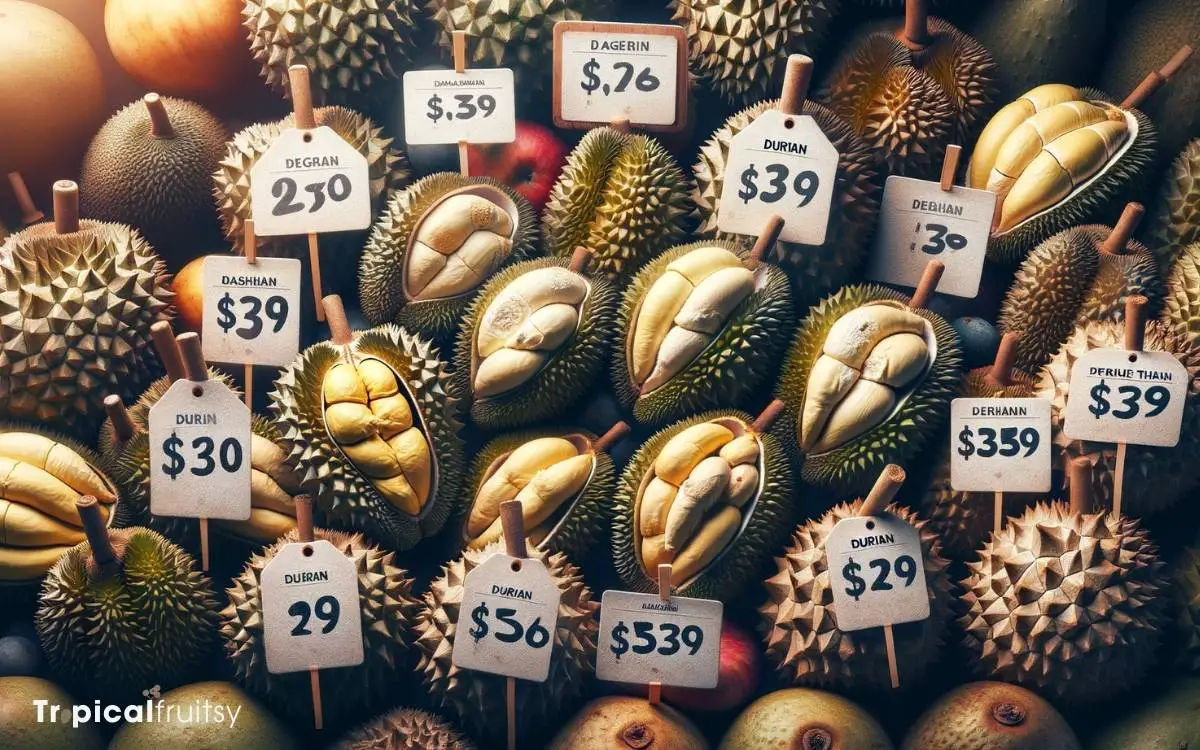
Key Takeaway
Durian Price Guide: Factors Affecting the Cost of Durian Fruit
| Factor | Description | Typical Impact on Price |
|---|---|---|
| Variety | Different durian types have varying prices (e.g., Musang King). | High-quality varieties are more expensive. |
| Season | Off-season durians are less available and more costly. | Prices are higher outside the peak harvest period. |
| Geography | Price varies in different regions, from Southeast Asia to worldwide. | Importing countries face higher prices. |
| Size and Quality | Larger and more pristine durians command higher prices. | Better quality increases cost. |
| Export Costs | International shipping and tariffs affect the final price. | Higher export costs raise retail prices. |
Understanding Durian Varieties
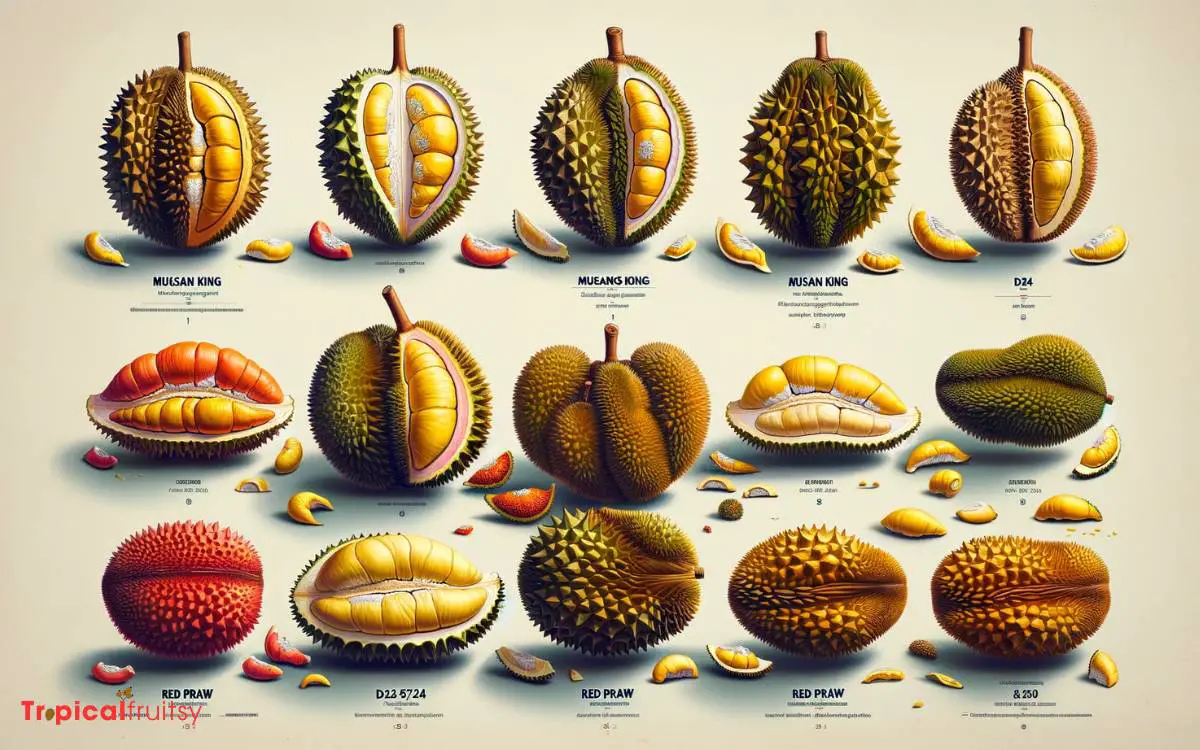
Several durian varieties exist, each with distinct flavors and textures that influence their market price.
The value of these varieties is underpinned by a complex interplay of factors, including rarity, taste, and cultivation requirements.
For instance, the Musang King variety, known for its vibrant yellow flesh and creamy, sweet taste with a hint of bitterness, commands a premium price due to its high demand and relatively limited supply.
On the other hand, the D24 variety, which is more widely available and offers a milder taste, is generally more affordable.
Experts assess the quality of durian based on criteria such as ripeness, texture, and absence of defects, which directly correlates to the fruit’s market valuation. Understanding these nuances is essential for consumers and investors alike.
Seasonal Impact on Prices
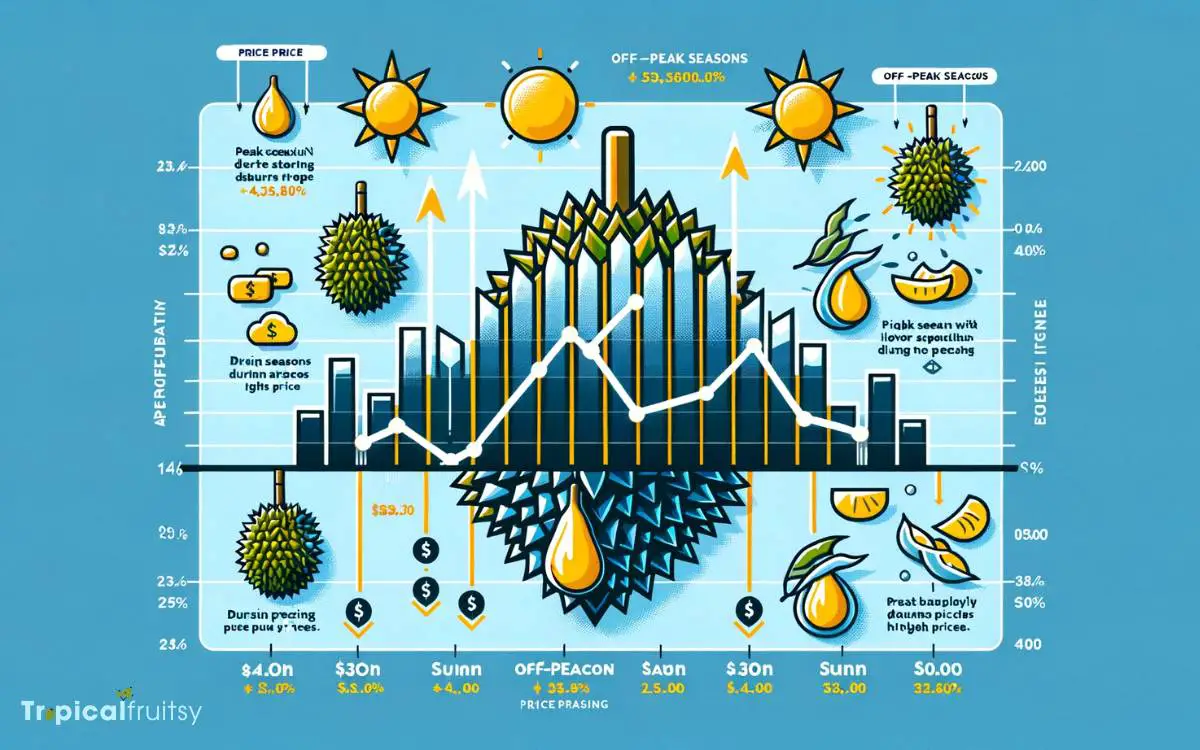
The cost of durian is significantly influenced by seasonal variations, with prices often peaking during the fruit’s high season due to increased demand and optimal harvesting conditions.
Conversely, during the off-season, durians become a premium commodity, as the reduced availability prompts a surge in prices, reflecting the additional efforts required to cultivate and supply the fruit outside its natural growth cycle.
These patterns of peak season fluctuations and off-season premiums are critical factors in the economic ebb and flow of the durian market, affecting both producers and consumers alike.
Peak Season Fluctuations
Durian prices often experience significant variations due to the influence of peak seasons on supply and demand dynamics.
During the peak season, typically spanning from June to August, durian production reaches its zenith, resulting in a temporary market saturation.
This surge in availability can lead to a marked decrease in price, as sellers vie to attract buyers in a competitive landscape rife with fresh stock.
Conversely, in the off-peak periods, the scarcity of durians drives prices upward, reflecting the classic economic principle of scarcity value. It is essential for consumers and retailers to understand these fluctuations to strategize their purchases and sales.
Analyzing past season trends can provide valuable insights into the potential price trajectory of durians in forthcoming peak seasons.
Off-season Premiums
Outside of the June to August peak season, durian enthusiasts must grapple with increased costs, as the fruit’s scarcity imposes a premium on its market price.
This off-season surge in price is attributable to several factors: diminished production, increased logistical expenses, and elevated demand against a limited supply.
During the off-peak months, durian trees yield significantly less fruit, leading to a sharp decline in market availability.
Growers and suppliers face heightened costs in maintaining and storing the perishable fruit, which, in turn, inflates the retail price.
Moreover, the persistent demand from avid consumers drives prices upward, reflecting the classic economic principle of scarcity value.
Consequently, off-season durians can command prices that are substantially higher, sometimes even doubling when compared to their peak-season rates.
Regional Price Differences
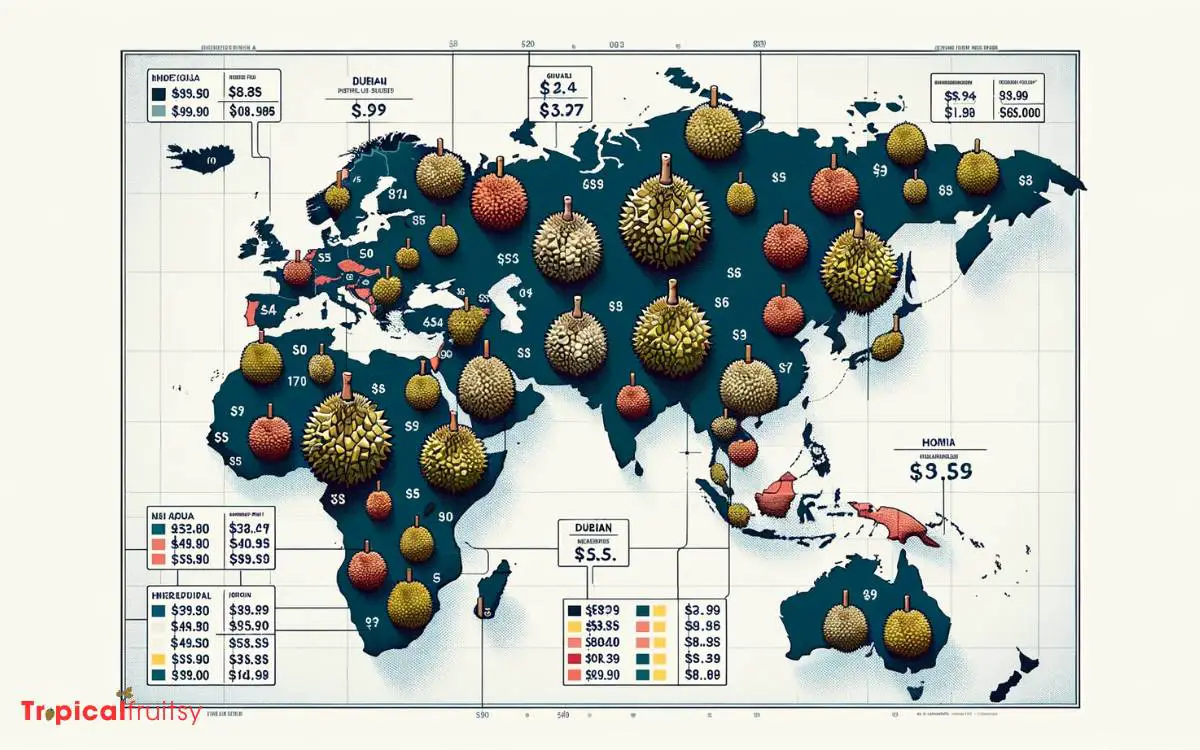
Prices for durians can vary significantly across different regions, reflecting factors such as local availability, demand, and cultivation costs.
In Southeast Asia, where durians are indigenous, prices are generally lower due to the fruit’s abundance and the established infrastructure for its cultivation and distribution.
For instance, in Malaysia and Thailand, durian prices are often a reflection of the variety and season, with the famed Musang King fetching a premium.
Conversely, in non-native regions such as the United States or Europe, prices are markedly higher. This is attributable to importation costs, limited suppliers, and the complexities of maintaining the fruit’s freshness over long distances.
Additionally, tariffs and trade regulations can further inflate costs, making durians a luxury item in these markets.
The price differential is a direct outcome of the interplay between geographic origin, supply chain efficiency, and market demand dynamics.
Size and Quality Considerations
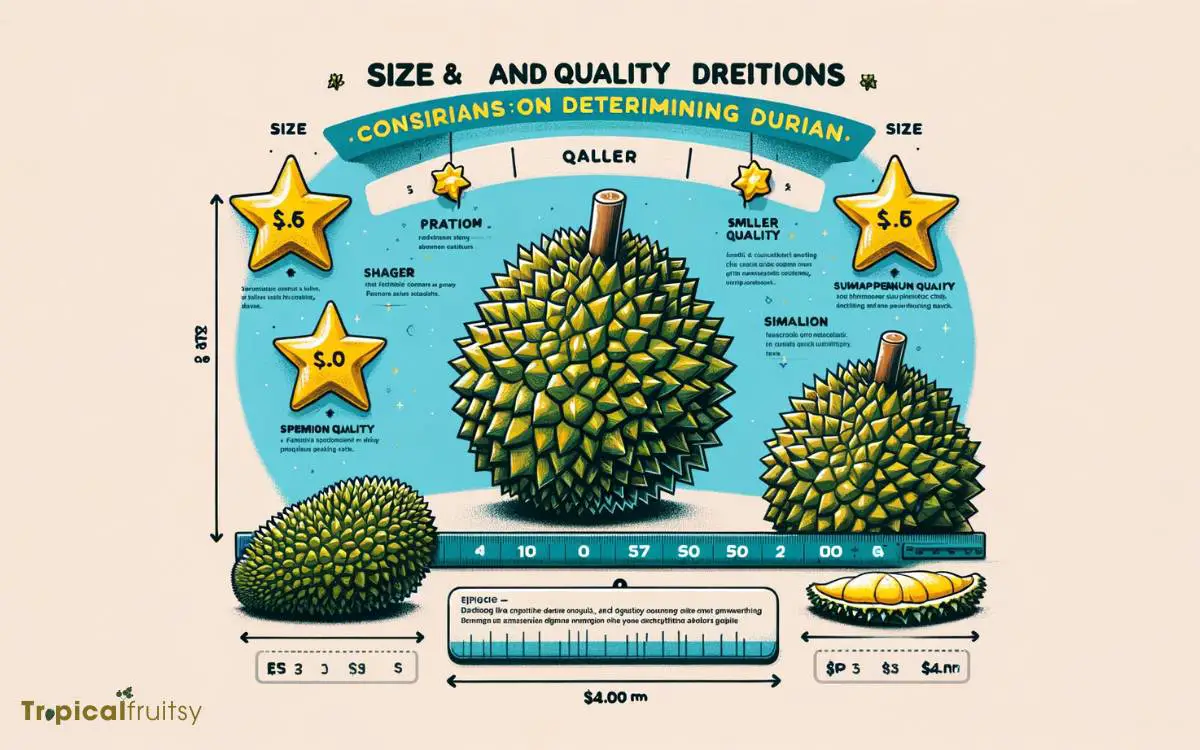
The cost of durians is influenced by multiple factors, including the size and quality of the fruit. Larger and more pristine specimens tend to command higher prices.
Quality assessment by connoisseurs involves evaluating various aspects. These include the fruit’s husk integrity, the absence of external blemishes, and the condition of the stem.
Internally, the flesh must exhibit a vibrant, consistent coloration, a characteristic aroma, and a texture that aligns with the variety’s profile.
Premium durians are those that present a uniform ripeness, without any signs of over-maturity or underdevelopment. Even minor imperfections can significantly impact the market value due to the intricacies of durian quality assessment.
As a result, buyers who are well-versed in these subtleties are willing to pay a premium for fruits that meet or exceed their stringent standards.
Export Costs and Tariffs
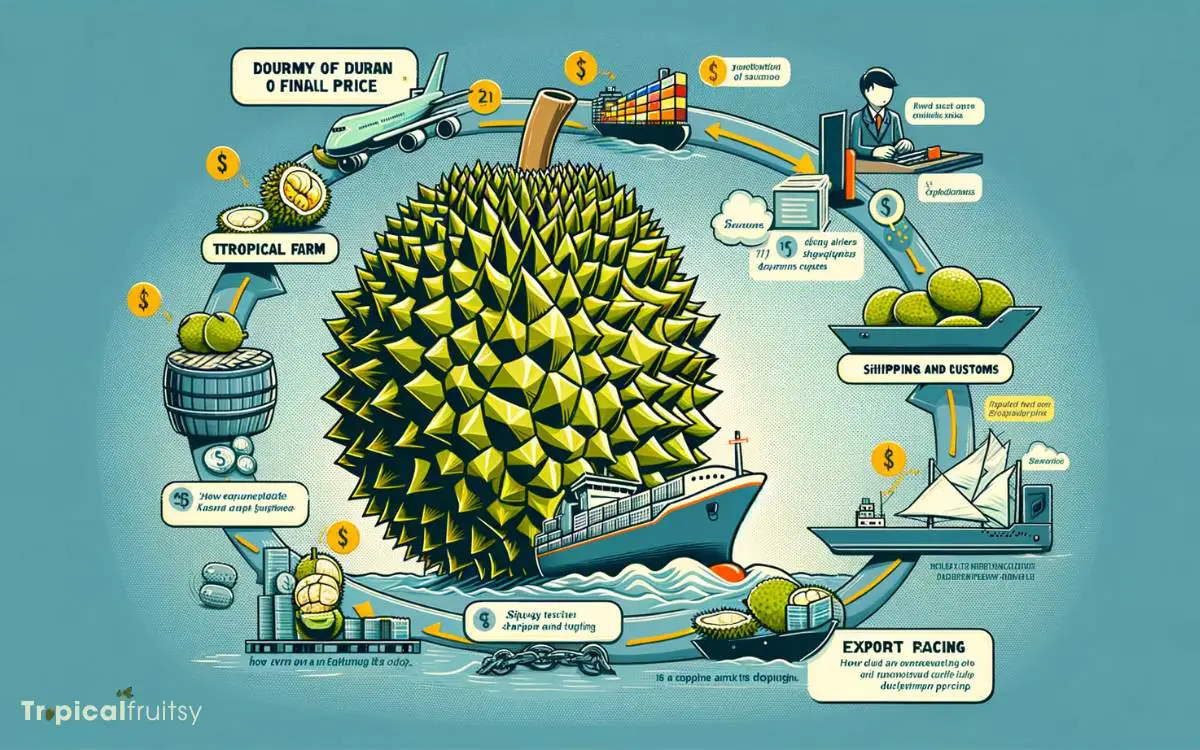
Additionally, export costs and tariffs invariably affect the retail price of durians in international markets.
These fiscal barriers reflect the complex economics of global trade and are shaped by myriad factors:
Export Costs:
- Logistics: Includes freight, insurance, and handling fees, which escalate with distance.
- Regulatory Compliance: Costs incurred from meeting the export standards of the destination country.
Tariffs:
- Ad Valorem Duties: Percentage-based tariffs that scale with the value of the imported goods.
- Specific Duties: Fixed fees imposed per unit, which can disproportionately impact lower-valued shipments.
These financial impositions contribute to the final cost to consumers and can fluctuate based on international relations and trade agreements. Understanding these dynamics is essential for potential importers and distributors.
Retailers and Marketplaces

Within retail environments and online marketplaces, durian pricing is subject to variances based on factors such as demand, availability, and seller discretion.
Retailers often consider the type of durian, with premium varieties like Musang King commanding higher prices.
Online marketplaces enable a wider reach, potentially reducing costs due to increased competition, but they also introduce shipping fees that can affect the final price.
| Retail Outlet | Price Range |
|---|---|
| Local Markets | $15 – $50 |
| Supermarkets | $20 – $60 |
| Online Stores | $25 – $70 |
Analyzing the data, it becomes evident that while local markets offer competitive pricing, they may have limited variety. Supermarkets provide convenience but at a markup.
Online stores present the broadest selection, yet the price reflects shipping and handling considerations.
How Much Does a Durian Weigh
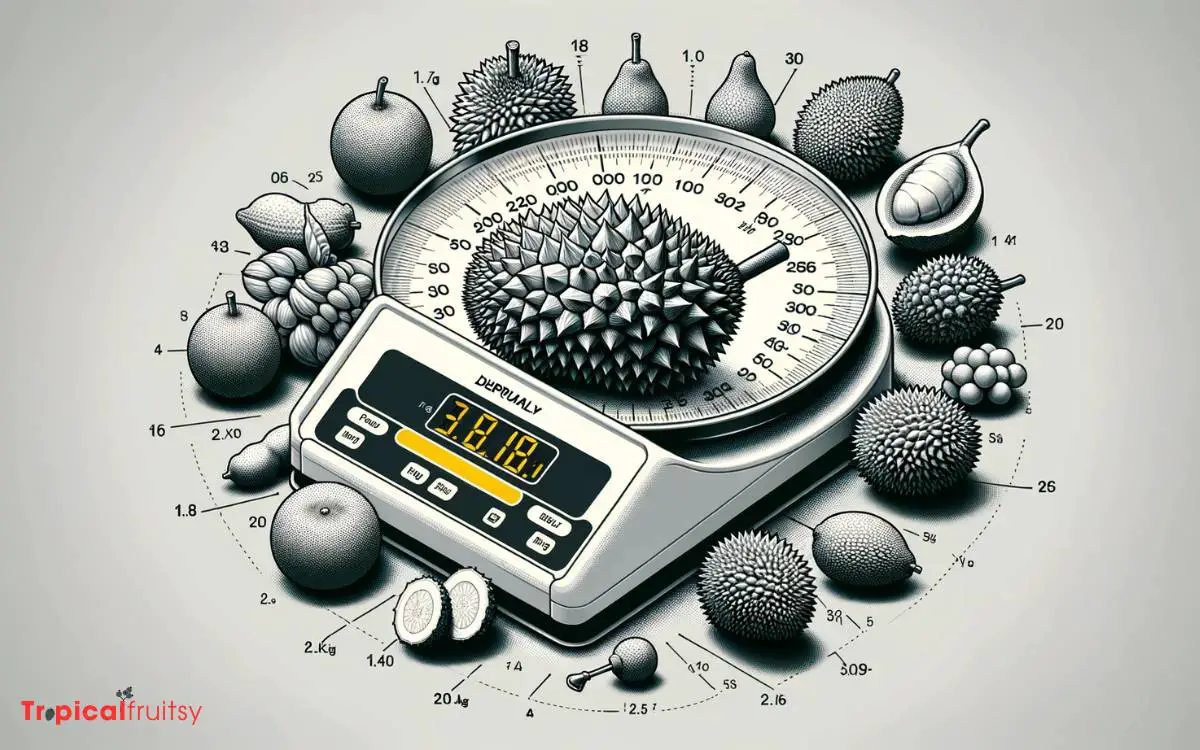
The weight of a durian can vary depending on several factors, including its size, variety, and ripeness. On average, a whole durian fruit can weigh anywhere from 2 to 7 pounds (approximately 1 to 3 kilograms).
However, some exceptionally large durians can weigh even more, occasionally reaching up to 10 pounds (4.5 kilograms) or more.
The weight of a durian is determined by the size of the fruit, with larger durians naturally being heavier. Additionally, the flesh-to-seed ratio inside the durian can also influence its weight.
Ripe durians will generally weigh more than unripe ones due to the moisture content and ripening process.
It’s worth noting that the weight of the edible flesh inside the durian is significantly less than the weight of the whole fruit because the durian contains large seeds.
The edible flesh usually makes up about one-third to one-half of the total weight of the fruit, depending on the variety and ripeness.
When purchasing durian, you are typically charged based on the total weight of the fruit, including the inedible husk, so keep that in mind when buying it.
Conclusion
The intriguing world of durian commerce reveals a complex tapestry influenced by variety, seasonality, geography, and quality. The fruit’s cost is further shaped by the intricacies of export logistics and market regulations.
Discerning consumers and traders must navigate this labyrinth to appreciate the financial nuances of this custard-like confection of the tropics.
Thus, the durian’s price tag is not merely a number but a reflection of an elaborate agricultural ballet.






